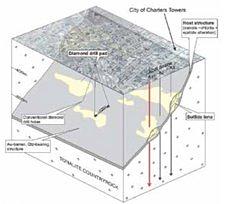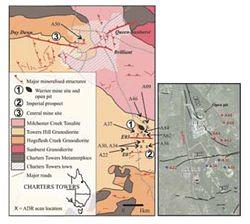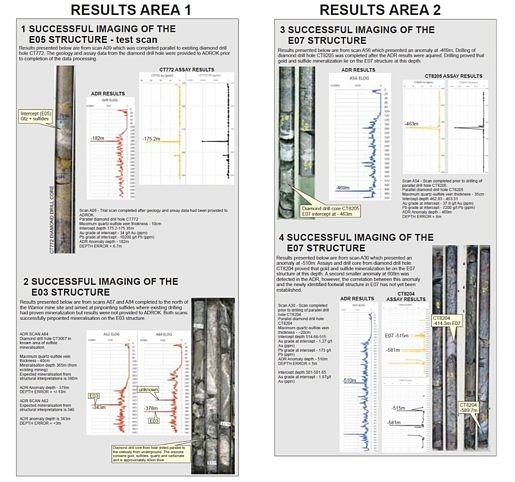Gold and sulfide targeting using Adrok's atomic dieelctric resonance (ADR) technique
Download Charters Gold presentation 2020
CITIGOLD required a technique to resolve a set of complex but non-unique mineral exploration and targeting problems.
AIM:
To locate small (< 50 x 50m) areas of high grade gold mineralisation hosted within a set of semi-predictable and semi-continuous fractures within granitic host rocks (FIG. 1).
Some exploration challenges:
- Mineralization is located directly beneath the city of Charters Towers thereby limiting the use of conventional drilling and other traditional geophysical techniques such as magnetics, gravity, IP, TEM, MT, Seismic reflection.
- The depth to mineralization is 400m to over 1500m
- Drilling is extremely slow and expensive and there is a lack of drill pad sites within the city
- The local granite is extremely hard resulting in an average drilling advance of 30-40m/day). using conventional diamond drilling


Geological context
- Mineralization is classified as “narrow vein” type as it is hosted within N- or NE-dipping, quartz-bearing dilatant fractures.
- Gold occurs with other sulfide phases including Galena (PbS), Pyrite (FeS2), Sphalerite ((Zn,Fe)S).
- High lead (Galena) grades equate to high gold
- The sulfide and gold-rich layers within the host fractures are typically less than 30cm thick.
- Gold and sulfides occur as lenses or “pods” within the host fracture zone.
- Fractures are up to 10m thick but average 1-2m thick
- Fractures containing quartz and carbonate as well as numerous cross-cuting basalt, intermediate and felsic dykes.
- The host rock is tonalite or granodiorite with
- Sulfides, quartz and low-grade gold ( < 1 - 5 m.g/t) are typically found within most of the fracture zone, however, high grade gold and sulfide lenses (incl. quartz) are typically small (< 100m in longest dimension) but exhibit high gold grades in excess of ~30 m.g/t Au.
- The structural controls on the location of high-grade gold mineralization are extremely complex and previous drilling/exploration has been carried out via inefficient diamond drilling

Benefits for CITIGOLD
- Fast data acquisition - Acquisition of over 60 individual scans occurred within a few weeks
- Fast processing - Data processing and return of results occurred within a few months
- Target acquisition - All ADR scans presented an anomaly at the target structure
- Confident depth estimates - Anomalies were within 13m of drilled or inferred target depth
- Very low impact - Very little to no environmental or social impact
Project outcomes
- In every case, the ADR technique identified the target structure. Drilling of one of the targets resulted in a significant intercept of 37.9 g/t Au
- Up to approximately 20m in position error between the ADR response and the physical structure was recorded. The average difference is, however, only around 5m
- No absolute measurement can be used to estimate/infer the grade of the rock at the point of intercept (at this stage)
- Diamond drilling after anomalies were identified in ADR proved that the ADR is precise in determining where and how many major structures are present in a vertical profile



